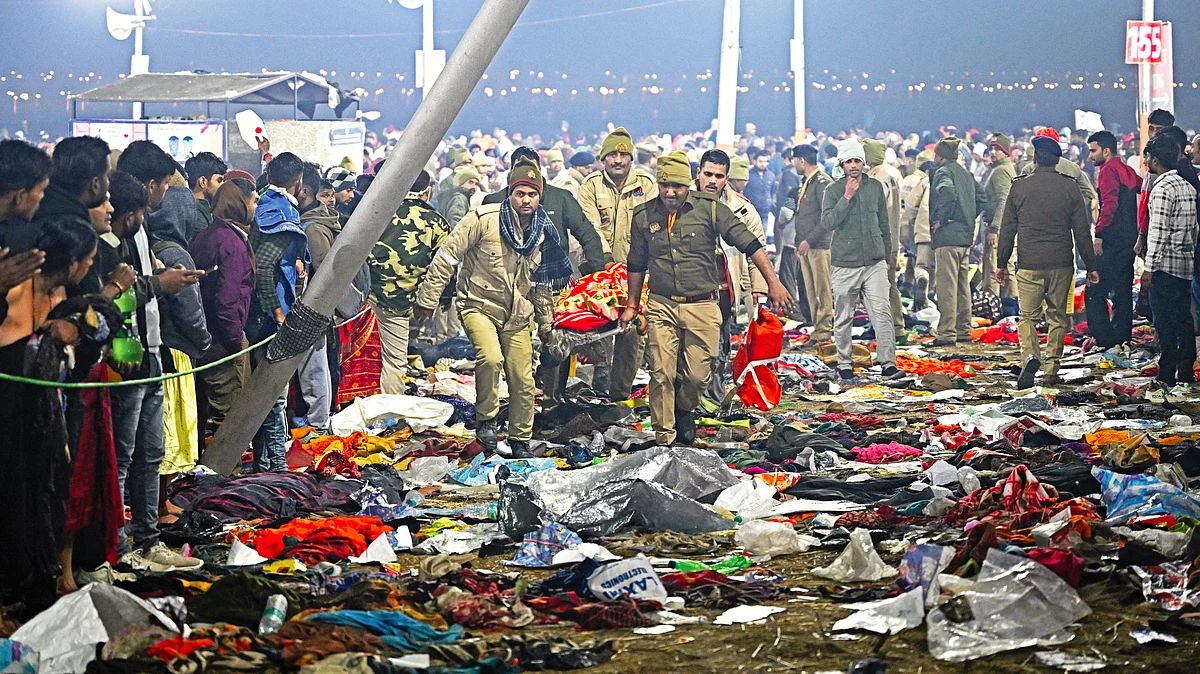Maha Kumbh: The triumphal PR exercise that failed
The Maha Kumbh requires a comprehensive audit not only because of the tragedy but also because of the scale of public money involved

The Maha Kumbh was designed as a triumphal showcase for Yogi Adityanath’s administrative and managerial skills. The stampede on 29 January and ensuing chaos tore that PR exercise to shreds. While ‘crisis management’ (read: denial and deafening silence) has momentarily stalled a political spiral, for the first time, even UP media outlets were heard questioning ‘bulldozer baba’.
Media coverage of the casualties has been starkly divided. While some exposed the discrepancies between different official versions, others chose to see, hear and speak no evil. Dainik Bhaskar, TV9Bharatvarsh and YouTube channels like 4PM, among others, accused the chief minister of a cover-up and lying both about the stampede and the death toll.
Some reported the death toll in the range of 250 to 2,500; others clung to the official claim of a ‘small incident’ of 30 deaths. Some reported on mismanagement, corruption, lack of coordination and VIP culture; others waxed eloquent on the grand arrangements.
Some journalists and influencers shared videos of distraught survivors, heaps of shoes, garments and personal belongings scattered across stampede sites; others shared videos of orderly devotees taking their dip, foreigners feeling blessed and sants accusing Avimukteshwaranand, the sankaracharya of Badrinath, of vilifying Yogi.
Many suspect the rift in the media reflects an internal rift in the BJP. No-holds-barred campaigns against Yogi would not be possible without a nod from some power-centre, possibly in an attempt to discredit him as a potential successor (read: threat) to Modi.
The UP government has consistently maintained the party line: the stampede was caused by devotees breaking barricades, 30 devotees lost their lives and 90 were injured. Meanwhile, on the ground, as many as 50 ambulances have been taking the injured to three hospitals in Prayagraj and one inside the Maha Kumbh area, and relatives are still desperately seeking information.
Some survivors were captured on video saying they were handed Rs 15,000 in cash and asked to take their dead away without any post-mortem, or handed certificates stating: ‘brought dead’. Bodies were reportedly flung into the river, buried in the sand and disposed in acid — such are the gory tales floating around.
Even a Yogi apologist like Yati Narsinghanand Saraswati of the Dasna Devi temple in Ghaziabad blamed the Mauni Amavasya stampede on official negligence.
Tania Mittal, an influencer engaged by the UP tourism department, embarrassed the government by claiming she witnessed horrific scenes and personally rescued hundreds of people. She wept on camera and claimed to have been injured herself before vanishing off the airwaves.
The UP government ordering a judicial probe by a magistrate and setting up a three-member inquiry committee seems half-baked. An inquiry under the Commission of Inquiry Act, which would give the commission the powers of a civil court and the right to summon witnesses and depositions, would have been more transparent. Such a commission would have notified the terms, taken control of CCTV footage, retrieved wireless communication, examined official correspondence, including police diaries and recorded statements of all stakeholders.
Journalists, YouTubers and seers need to be invited to depose. The four integrated control and command centres also require scrutiny as does the footage captured by drones. The Maha Kumbh requires a comprehensive audit not only because of the tragedy but also because of the scale of public money involved.
The UP government had claimed that it was spending Rs 7,500 crore but generating business worth Rs 2 lakh crore. An FIR lodged after a fire broke out at the Justa Shivir, an unauthorised tent city within the mela ground, blew the lid off a corruption scandal. These tents with upwards of Rs 20,000 per night as rent could not have been set up without the complicity of officials. Land was allotted, water and power connections provided, geysers installed. A short circuit led to the fire.
A marketing executive claimed that publicity contracts were awarded on the understanding that hefty cash paybacks would be made to the authorities, which were, he said, highest for outdoor advertising “going up to 50 per cent and above”.
Instead of acting responsibly, the inquiry committee is likely to blame unknown miscreants and saboteurs for having engineered the stampedes to defame Modi and Yogi.
****
Muslims, who were asked to stay away from the Kumbh, are the ones who opened their homes to provide food and shelter to Hindu devotees in distress. Mohit Kadam from Nasik, Maharashtra, said, “We didn’t know where to go after the stampede. The milling crowd made it difficult to move or even breathe. Some people took us to Yadgare Hussaini Inter College, where they provided food and arranged for our stay. It was a very comforting experience.”
Several mosques including the Khuldabad Sabzi Mandi Mosque, Bada Tazia Imambara, Himmatganj Dargah and Chowk Mosque turned into temporary shelters. Several localities organised impromptu canteens to serve halwa-puri. Mohammad Irshad of Bahadurganj (Daira) told Dainik Bhaskar, “After the stampede, we saw thousands shivering in the freezing night. We welcomed as many people as possible into our homes…they were our guests in Prayagraj, and we did our best to look after them.”
Follow us on: Facebook, Twitter, Google News, Instagram
Join our official telegram channel (@nationalherald) and stay updated with the latest headlines
